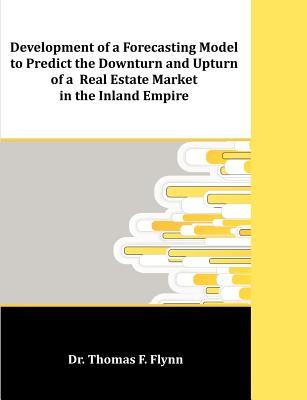
- We will send in 10–14 business days.
- Author: Thomas F Flynn
- Publisher: Dissertation.Com
- Year: 2011
- Pages: 378
- ISBN-10: 1599423944
- ISBN-13: 9781599423944
- Format: 18.9 x 24.6 x 2 cm, minkšti viršeliai
- Language: English
- SAVE -10% with code: EXTRA
Development of a Forecasting Model to Predict the Downturn and Upturn of a Real Estate Market in the Inland Empire (e-book) (used book) | bookbook.eu
Reviews
Description
Amidst the dramatic real estate fluctuations in the first decade of the twenty-first century, this study recognized that there is a necessity to create a real estate prediction model for future real estate ventures and prevention of losses such as the mortgage meltdown and housing bust. This real estate prediction model study sought to reinstall the integrity into the American building and development industry, which was tarnished by the sudden emergence of various publications offering get-rich-quick schemes. In the fast-paced and competitive world of lending and real estate development, it is becoming more complex to combine current and evolving factors into a profitable business model. This prediction model correlated past real estate cycle pinpoints to economical driving forces in order to create an ongoing formula. The study used a descriptive, secondary interpretation of raw data already available. Quarterly data was taken from the study's seven independent variables over a 24-year span from 1985 to 2009 to examine the correlation over two real estate cycles. Public information from 97 quarters (1985-2009) was also gathered on seven topics: consumer confidence, loan origination volume, construction employment statistics, migration, GDP, inflation, and interest rates. The Null hypothesis underwent a test of variance at a .05 level of significance. Multiple regression analysis uncovered that four of seven variables have correlated and could predict movement in real estate cycle evidence from previous data, based in the Inland Empire. GDP, interest rates, loan origination volume, and inflation were the four economical driving variables that completed the Inland Empire's real estate prediction model and global test. Findings from this study certify that there is correlation between economical driving factors and the real estate cycle. These correlations illustrate patterns and trends, which can become a prediction model using statistics. By interpreting and examining the data, this study believes that the prediction model is best utilized through pinpointing an exact numerical location by running calculations through the established global equation, and recommends further research and regular update of quarterly trends and movements in the real estate cycle and specific variables in the formula.
EXTRA 10 % discount with code: EXTRA
The promotion ends in 22d.17:30:52
The discount code is valid when purchasing from 10 €. Discounts do not stack.
- Author: Thomas F Flynn
- Publisher: Dissertation.Com
- Year: 2011
- Pages: 378
- ISBN-10: 1599423944
- ISBN-13: 9781599423944
- Format: 18.9 x 24.6 x 2 cm, minkšti viršeliai
- Language: English English
Amidst the dramatic real estate fluctuations in the first decade of the twenty-first century, this study recognized that there is a necessity to create a real estate prediction model for future real estate ventures and prevention of losses such as the mortgage meltdown and housing bust. This real estate prediction model study sought to reinstall the integrity into the American building and development industry, which was tarnished by the sudden emergence of various publications offering get-rich-quick schemes. In the fast-paced and competitive world of lending and real estate development, it is becoming more complex to combine current and evolving factors into a profitable business model. This prediction model correlated past real estate cycle pinpoints to economical driving forces in order to create an ongoing formula. The study used a descriptive, secondary interpretation of raw data already available. Quarterly data was taken from the study's seven independent variables over a 24-year span from 1985 to 2009 to examine the correlation over two real estate cycles. Public information from 97 quarters (1985-2009) was also gathered on seven topics: consumer confidence, loan origination volume, construction employment statistics, migration, GDP, inflation, and interest rates. The Null hypothesis underwent a test of variance at a .05 level of significance. Multiple regression analysis uncovered that four of seven variables have correlated and could predict movement in real estate cycle evidence from previous data, based in the Inland Empire. GDP, interest rates, loan origination volume, and inflation were the four economical driving variables that completed the Inland Empire's real estate prediction model and global test. Findings from this study certify that there is correlation between economical driving factors and the real estate cycle. These correlations illustrate patterns and trends, which can become a prediction model using statistics. By interpreting and examining the data, this study believes that the prediction model is best utilized through pinpointing an exact numerical location by running calculations through the established global equation, and recommends further research and regular update of quarterly trends and movements in the real estate cycle and specific variables in the formula.


Reviews